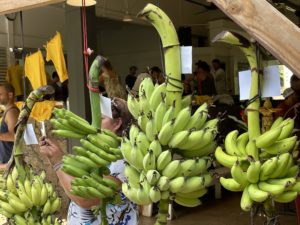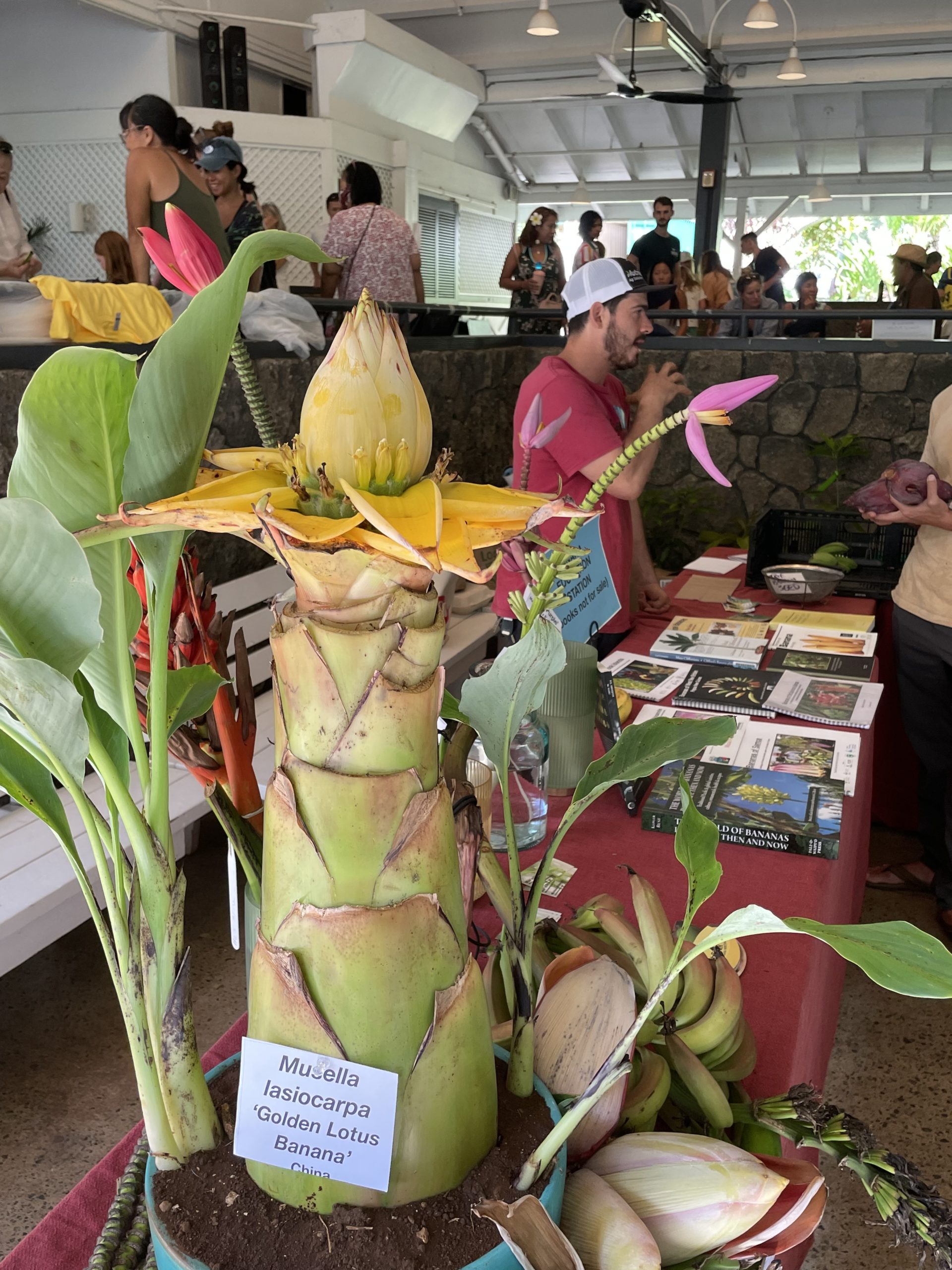By Laurie Carlson, Slow Food O’ahu
 This past November, The Banana Source, Hawai’i SEED, Slow Food in Hawai’i and Waimea Valley hosted the inaugural Mai’a Ho’olaule’a / Banana Festival on the North Shore of O’ahu. Over 1,600 people came to eat, design with and learn how best to grow bananas.
This past November, The Banana Source, Hawai’i SEED, Slow Food in Hawai’i and Waimea Valley hosted the inaugural Mai’a Ho’olaule’a / Banana Festival on the North Shore of O’ahu. Over 1,600 people came to eat, design with and learn how best to grow bananas.
Ka Mai‘a ‘Ho‘olaule‘a was attended by residents from all over O’ahu, as well as visitors who happened upon it during their Waimea visit. Ka Mai‘a ‘Ho’olaule‘a succeeded in opening up a world of banana flavors and colors. It expanded notions of what a banana is and can be. The numerous activities and events were created to help our community successfully grow and use bananas in new ways.
well as visitors who happened upon it during their Waimea visit. Ka Mai‘a ‘Ho’olaule‘a succeeded in opening up a world of banana flavors and colors. It expanded notions of what a banana is and can be. The numerous activities and events were created to help our community successfully grow and use bananas in new ways.
 Fairgoers enthusiastically sampled more than ten varieties of raw bananas at our 18-foot-long monkeypod table. Two of these were “canoe” bananas that were brought to Hawai’i by Polynesian voyagers centuries ago. One type, the orange-fleshed Iholena banana, was one of the few kinds of bananas that women and children were allowed to eat in old Hawai’i. Iholena gets its color from pro-beta carotene, which also gives the unique orange color to carrots.
Fairgoers enthusiastically sampled more than ten varieties of raw bananas at our 18-foot-long monkeypod table. Two of these were “canoe” bananas that were brought to Hawai’i by Polynesian voyagers centuries ago. One type, the orange-fleshed Iholena banana, was one of the few kinds of bananas that women and children were allowed to eat in old Hawai’i. Iholena gets its color from pro-beta carotene, which also gives the unique orange color to carrots.
Several chefs shared their takes on the use of bananas in the culinary realm including the Filipino dish banana flower adobo, bananas foster, curried bananas, Puerto Rican pastele and traditional Hawaiian piele (bananas with coconut milk). Recipe booklets of savory mai’a dishes were distributed so that attendees could continue their culinary adventures at home.
dish banana flower adobo, bananas foster, curried bananas, Puerto Rican pastele and traditional Hawaiian piele (bananas with coconut milk). Recipe booklets of savory mai’a dishes were distributed so that attendees could continue their culinary adventures at home.
Gabe Sachter-Smith, owner of The Banana Source, gave a speech and slideshow on banana culinary lore, botanical history and best growing practices. Ken Love, Executive Director of Hawaii Tropical Fruit Growers, followed this up with his speech on preservation techniques and backyard fruit growing.
 A hands-on booth supplied t-shirts, tote bags and an array of banana plant parts as well as dyes and inks. Fabulous patterns from stems, stalks and flowers were created by delighted festival participants big and small.
A hands-on booth supplied t-shirts, tote bags and an array of banana plant parts as well as dyes and inks. Fabulous patterns from stems, stalks and flowers were created by delighted festival participants big and small.
A lauhala (pandanus) weaving demonstration was presented by Mahina Pukahi of Waianae. Traditionally, black banana fibers were used in combination with lauhala to create definition and contrast.
Festival t-shirts nearly sold out, being a popular hit with attendees. We also sold numerous copies of the ultimate guide to all things banana: The World of Bananas in Hawai’i Then and Now by Angela Kepler.  This book educates people about mai’a history, best gardening practices, pests, identification, and how best to prepare, cook and eat bananas. The few copies available sold out quickly.
This book educates people about mai’a history, best gardening practices, pests, identification, and how best to prepare, cook and eat bananas. The few copies available sold out quickly.
The Banana Source booth had an impressive display of flowering bananas, including the lovely and unique Golden Lotus banana from Yunnan, China. Home growers were able to buy banana keiki including apple bananas, saba, nam wah, silk, pisang lilin, ice cream, largo, iholena, plantains and gros michel. Over 280 plants were sold during the festival, supporting our efforts to improve Mai’a biodiversity by getting a wider selection of bananas into Hawaii’s gardens, kitchens, farms and back yards.
buy banana keiki including apple bananas, saba, nam wah, silk, pisang lilin, ice cream, largo, iholena, plantains and gros michel. Over 280 plants were sold during the festival, supporting our efforts to improve Mai’a biodiversity by getting a wider selection of bananas into Hawaii’s gardens, kitchens, farms and back yards.
For more information check out the Slow Food O’ahu website and Facebook page.








